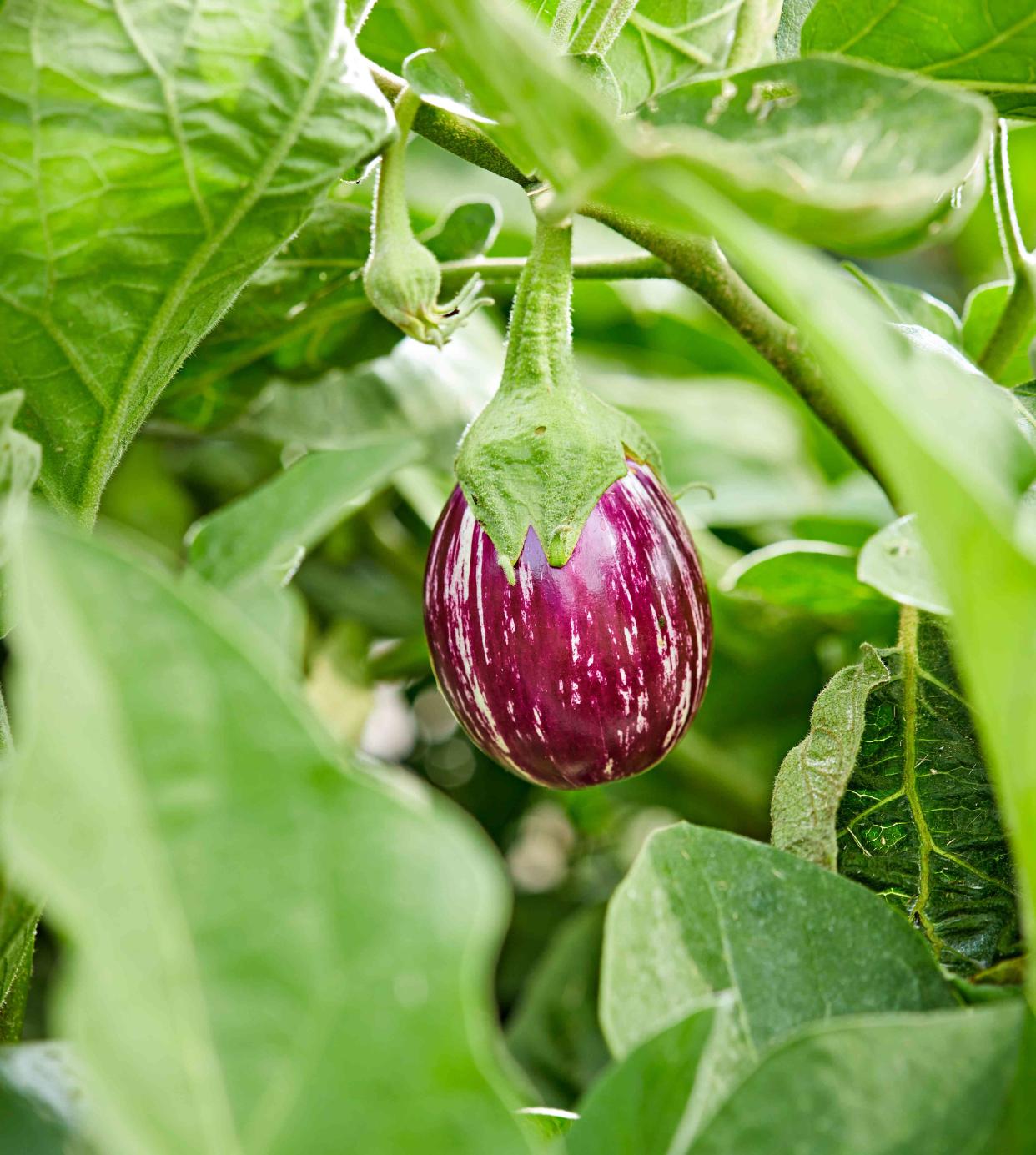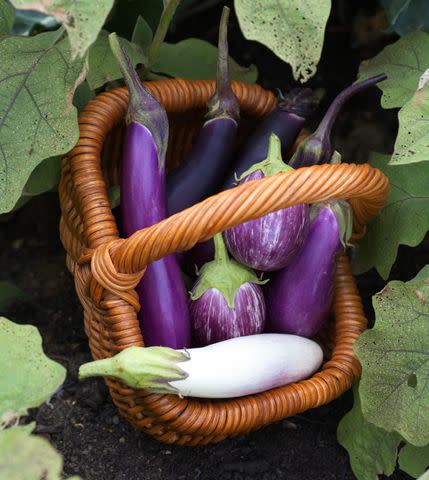How to Plant and Grow Eggplant
Curious about growing eggplant? Learn everything you need to know to grow this delicious vegetable.

Eggplants (Solanum melongena) are delightfully versatile in the kitchen. They are usually deep purple, large, and egg-shaped, but they also come in light purple, green, white, and bicolored, and they vary in size and shape.
Eggplants can be grilled as steaks, added to stir-fries, stuffed and roasted, or pickled. If eggplant parmesan, baba ganoush, moussaka, and caponata make your mouth water, you should try growing eggplant. Understanding and satisfying eggplant’s growing needs will deliver a hearty summer harvest for all your favorite recipes.
Eggplant is a member of the nightshade family, which includes tomatoes, potatoes, and peppers. Although eggplant is a perennial in frost-free, semi-tropical regions, it is almost always treated as an annual.
Note: Ingesting the leaves, flowers, stems, and unripe fruit of eggplants is toxic to humans and pets.
Where to Plant Eggplant
Grow eggplant in a sunny spot in rich, well-drained soil, either in the vegetable garden or in a sunny border where its small 5-lobed flowers, large green leaves, and shiny purple, white, or striped fruit provide a bold contrast to colorful annual flowers.
Although it can be planted in rows in the vegetable garden, many varieties are pretty enough to include in an ornamental bed.
How and When to Plant Eggplant
Eggplants need warm temperatures from the beginning, so wait until mid to late spring, when night temperatures are consistently above 60°F before planting seedlings outside. Cool temperatures cause stunting, and the plants may never recover fully. If you are growing from seed, start your eggplant 8 to 10 weeks before your area is past all danger of frost. Optionally, purchase seedlings from a nursery, but don’t plant them outside until the weather warms. Soil temperatures should be 70°F or above.
Harden off seedlings grown indoors by taking them outside in an area protected from wind. Leave them outside for 30 to 60 minutes on the first day, increasing the outside time gradually over a week to 10 days, after which they should be acclimated to outdoor conditions. Water the seedlings well and plant on a cloudy day. Dig a hole and set the seedlings in well-prepared soil at the same depth as they were growing in the pot. Space eggplants at least 2 feet apart and water thoroughly. Mulch to help control weeds.
Tips
If you live where springs are cool and seasons are short, you can gain a few weeks of growing time by covering the prepared soil with black plastic a few weeks before planting. Cut an “X” through the plastic and dig a hole when you plant each seedling. Leave the plastic in place to keep the soil warm and discourage weeds.
If any seedlings have formed flowers or small fruit at planting time, remove them so the plant’s energy is directed toward root and leaf growth while it becomes established.
Soon after planting, insert a bamboo or wooden stake close to the seedling to provide support as the plant grows, or use a tomato cage. Eggplant fruit can be heavy.
Eggplant Care Tips
Although eggplants are sensitive to cold, they are relatively easy to grow when the conditions are right. Wait to plant until warm weather, and be sure the plants get plenty of sunshine and water. Space them so there is good air circulation between plants to avoid disease issues. After the plant starts to produce fruit, harvest it often for best fruit production.
Light
Eggplants love sun. Plant them where they receive at least 6 to 8 hours of full sun daily.
Soil and Water
The soil should be well-drained, with a pH of 5.5 to 7.0. Prepare the soil prior to planting by adding finished compost or well-rotted manure and thoroughly working it into the soil to a depth of 6 to 8 inches.
Eggplants need about an inch of water each week but may need more during the hottest part of the summer. If you don’t receive an inch of rain, supplement it with a hose. Avoid wetting the leaves as this can spread disease. Eggplant responds well to a drip or trickle irrigation system. A lack of water results in low fruit production.
Temperature and Humidity
Eggplant thrives in temperatures between 70°F and 90°F and average humidity. Protect young plants from unexpected cool weather by placing row covers over them until the temperatures warm.
Fertilizer
If you add compost or manure to the soil before planting, all you need to use at planting time is a mild liquid fertilizer such as fish emulsion. You can reapply fish emulsion every three or four weeks if the plants seem to need a boost. Avoid any fertilizer that is high in nitrogen because this stimulates vegetative growth at the expense of flowering and fruiting.
Pruning
Pruning eggplant isn’t usually necessary. However, if you see suckers sprouting from the base of the plant, pinch them off so the plant will use its energy to grow larger fruit.
Potting and Repotting
Eggplant is a good choice for containers, and it often escapes common pest problems when it’s grown outside the vegetable garden with good air circulation around its container. Select a large pot—a 5-gallon pot is a good choice—and use a high-quality potting mix. Add some slow-release fertilizer according to the label instructions if the mix doesn’t contain fertilizer, and be sure the container drains well. Position the eggplant in the container at the same level it was growing in its seedling pot. Place it in a sunny location and keep the soil moist but not soggy. Eggplant is usually grown as an annual, so it doesn’t require repotting.
Pests and Problems
Eggplants are susceptible to several pests; however, if your plants are healthy and vigorous, they can usually withstand most of them. Provide good air circulation by proper spacing. If you have the room, you may want to locate the eggplants in an area away from other vegetables. The most common pest is the flea beetle—a tiny black or brown beetle that chews tiny holes in leaves. A significant infestation can set back young plants, so it is a good idea to cover them with a floating row cover until they are sturdier. Mature plants can usually withstand the beetles feeding on them without much damage.
Aphids and spider mites are sometimes a problem. A hard stream of cold water usually reduces the population, so they cause minimal damage. Like other nightshade crops, eggplants may be attacked by Colorado potato beetles. Hand-picking is the best way to control them.
Eggplants occasionally suffer from a few diseases, including verticillium wilt—a soil-borne fungus. Avoidance is the key. Use a high-quality seedling mix when starting seeds, and don’t plant where tomatoes, peppers, potatoes, or eggplant have grown in the past three years.
Another fungal disease, anthracnose, causes dark sunken spots on overripe fruit. Harvest the fruit as soon as it’s mature to avoid the problem. Remove any fruit with symptoms so the disease does not spread.
Harvesting Eggplant
Harvest eggplant when the fruit is close to its full size, which varies among varieties, and the skin is shiny. Use a knife or snips to cut the fruit stem so you don’t injure the plant. Don’t let ripe fruit remain on the plant because it will become bitter, and fruiting will slow. The more you harvest, the more you’ll get.
How to Propagate Eggplant
The best way to start your eggplant is to sow seeds indoors eight to 10 weeks before you want to transplant them into the garden. Use a high-quality seed starting mix and sow two or three seeds to a pot, covering them with about ¼ inch of soil. Use a heat mat for best results because eggplants need warm soil. Keep the medium moist but not soggy. Seeds should germinate in one to two weeks.
Once the seeds germinate, remove the heat mat and place the seedlings under bright grow lights for 12 to 14 hours a day. Keep the lights about 6 inches above the tops of plants while they grow. After they have a couple of pairs of leaves, thin to the strongest seedling. Fertilize with ½ strength fish emulsion every 10 days unless your growing mix contains fertilizer. If the seedlings outgrow their pots, transplant each one to a larger pot, taking care to disturb the roots as little as possible. Be sure to harden off the seedlings before you transplant them outdoors.
Related: The 11 Best Grow Lights to Help Your Plants Thrive, Based on Testing

Types of Eggplant
Eggplant varieties differ in the size of the plant and the size, shape, and color of its fruit.
‘Black Beauty’
‘Black Beauty’ eggplant is an heirloom variety that produces large, dark purple fruit, perfect for grilled eggplant steaks or eggplant parmesan. Plants grow to 2 feet tall, and the fruit begins to ripen about 74 days after transplanting.
‘Summer Emerald’
‘Summer Emerald’ bears long, lime-green fruit that has very few seeds and thin skins on plants that grow up to 3 feet tall. Its 7-inch fruit begins to mature within 65 days of transplanting.
‘Gretel’
‘Gretel’ is a heavy producer of 3- to 4-inch white fruit on 2- to 3-foot plants. The non-bitter fruit is excellent for caponata and begins to mature in 55 days.
‘Fairy Tale’
‘Fairy Tale’ bears 2- to 4-inch-long fruit on compact plants that reach 18 to 24 inches tall. The fruit is speckled purple and white and is not bitter. It matures in 65 days.
Eggplant Companion Plants
Eggplants are susceptible to the usual garden pests, but the damage can be minimized by planting them with French marigolds, oregano, mint, and other companion plants.
Oregano
Bees and beneficial insects are attracted to oregano flowers and serve as efficient pollinators for nearby eggplants, increasing the yield. Oregano also repels other harmful pests and insects, including the cabbage butterfly and cucumber beetle.
French Marigolds
French marigolds repel several common eggplant pests, including nematodes. When in bloom, they also attract beneficial insects, such as lacewings, which prey on aphids.
Mint
The unmistakable scent of mint protects eggplants from flea beetles and aphids, and the plant’s flowers attract pollinators. However, mint can be invasive, so it should be contained in pots positioned near the eggplants.
Frequently Asked Questions
Does eggplant come back each year?
Eggplants are hardy only in the warmest regions (Zones 10, 11, and 12). Although it is a perennial in these warm zones, it is still usually grown annually, just like it is in cooler regions where it is not hardy. New plants are started each year from seed.
Are eggplants nutritious?
Yes. Eggplants are high in fiber, low in calories, and rich in antioxidants. They also contain manganese, folate, potassium, and vitamin K.
For more Better Homes & Gardens news, make sure to sign up for our newsletter!
Read the original article on Better Homes & Gardens.
